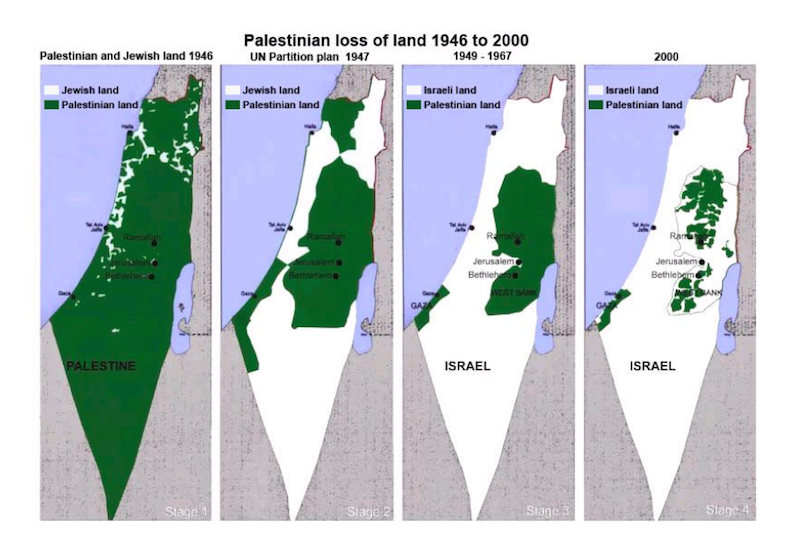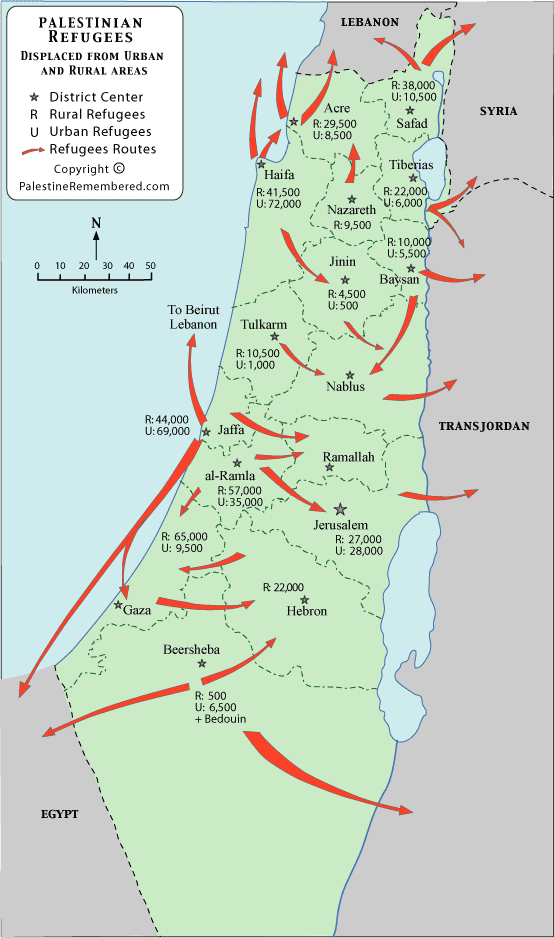Juan Cole prints a map and the blogosphere erupts
… As part of my original posting, I mirrored a map of modern Palestinian history that has the virtue of showing graphically what has happened to the Palestinians politically and territorially in the past century.
Andrew Sullivan then mirrored the map from my site, which set off a lot of thunder and noise among anti-Palestinian writers like Jeffrey Goldberg of the Atlantic, but shed very little light. (PS, the map as a hard copy mapcard is available from Sabeel.)

The map is useful and accurate. It begins by showing the British Mandate of Palestine as of the mid-1920s. The British conquered the Ottoman districts that came to be the Mandate during World War I (the Ottoman sultan threw in with Austria and Germany against Britain, France and Russia, mainly out of fear of Russia).
But because of the rise of the League of Nations and the influence of President Woodrow Wilson’s ideas about self-determination, Britain and France could not decently simply make their new, previously Ottoman territories into mere colonies. The League of Nations awarded them “Mandates.” Britain got Palestine, France got Syria (which it made into Syria and Lebanon), Britain got Iraq.
The League of Nations Covenant spelled out what a Class A Mandate (i.e. territory that had been Ottoman) was:
“Article 22. Certain communities formerly belonging to the Turkish Empire have reached a stage of development where their existence as independent nations can be provisionally recognised subject to the rendering of administrative advice and assistance by a Mandatory [i.e., a Western power] until such time as they are able to stand alone. The wishes of these communities must be a principal consideration in the selection of the Mandatory.”
That is, the purpose of the later British Mandate of Palestine, of the French Mandate of Syria, of the British Mandate of Iraq, was to ‘render administrative advice and assistance” to these peoples in preparation for their becoming independent states, an achievement that they were recognized as not far from attaining. The Covenant was written before the actual Mandates were established, but Palestine was a Class A Mandate and so the language of the Covenant was applicable to it. The territory that formed the British Mandate of Iraq was the same territory that became independent Iraq, and the same could have been expected of the British Mandate of Palestine. (Even class B Mandates like Togo have become nation-states, but the poor Palestinians are just stateless prisoners in colonial cantons).
The first map thus shows what the League of Nations imagined would become the state of Palestine. The economist published an odd assertion that the Negev Desert was ‘empty’ and should not have been shown in the first map. But it wasn’t and isn’t empty; Palestinian Bedouin live there, and they and the desert were recognized by the League of Nations as belonging to the Mandate of Palestine, a state-in-training. The Mandate of Palestine also had a charge to allow for the establishment of a ‘homeland’ in Palestine for Jews (because of the 1917 Balfour Declaration), but nobody among League of Nations officialdom at that time imagined it would be a whole and competing territorial state. There was no prospect of more than a few tens of thousands of Jews settling in Palestine, as of the mid-1920s. (They are shown in white on the first map, refuting those who mysteriously complained that the maps alternated between showing sovereignty and showing population). As late as the 1939 British White Paper, British officials imagined that the Mandate would emerge as an independent Palestinian state within 10 years.
In 1851, there had been 327,000 Palestinians (yes, the word ‘Filistin’ was current then) and other non-Jews, and only 13,000 Jews. In 1925, after decades of determined Jewish immigration, there were a little over 100,000 Jews, and there were 765,000 mostly Palestinian non-Jews in the British Mandate of Palestine. For historical demography of this area, see Justin McCarthy’s painstaking calculations; it is not true, as sometimes is claimed, that we cannot know anything about population figures in this region. See also his journal article, reprinted at this site. The Palestinian population grew because of rapid population growth, not in-migration, which was minor. The common allegation that Jerusalem had a Jewish majority at some point in the 19th century is meaningless. Jerusalem was a small town in 1851, and many pious or indigent elderly Jews from Eastern Europe and elsewhere retired there because of charities that would support them. In 1851, Jews were only about 4% of the population of the territory that became the British Mandate of Palestine some 70 years later. And, there had been few adherents of Judaism, just a few thousand, from the time most Jews in Palestine adopted Christianity and Islam in the first millennium CE all the way until the 20th century. In the British Mandate of Palestine, the district of Jerusalem was largely Palestinian.
The rise of the Nazis in the 1930s impelled massive Jewish emigration to Palestine, so by 1940 there were over 400,000 Jews there amid over a million Palestinians.
The second map shows the United Nations partition plan of 1947, which awarded Jews (who only then owned about 6% of Palestinian land) a substantial state alongside a much reduced Palestine. Although apologists for the Zionist movement say that the Zionists accepted this partition plan and the Arabs rejected it, that is not entirely true. Zionist leader David Ben Gurion noted in his diary when Israel was established that when the US had been formed, no document set out its territorial extent, implying that the same was true of Israel. We know that Ben Gurion was an Israeli expansionist who fully intended to annex more land to Israel, and by 1956 he attempted to add the Sinai and would have liked southern Lebanon. So the Zionist “acceptance” of the UN partition plan did not mean very much beyond a happiness that their initial starting point was much better than their actual land ownership had given them any right to expect.
The third map shows the status quo after the Israeli-Palestinian civil war of 1947-1948. It is not true that the entire Arab League attacked the Jewish community in Palestine or later Israel on behalf of the Palestinians. As Avi Shlaim has shown, Jordan had made an understanding with the Zionist leadership that it would grab the West Bank, and its troops did not mount a campaign in the territory awarded to Israel by the UN. Egypt grabbed Gaza and then tried to grab the Negev Desert, with a few thousand badly trained and equipped troops, but was defeated by the nascent Israeli army. Few other Arab states sent any significant number of troops. The total number of troops on the Arab side actually on the ground was about equal to those of the Zionist forces, and the Zionists had more esprit de corps and better weaponry.
[The nascent Israeli military deliberately pursued a policy of ethnically cleansing non-combatant Palestinians from Israeli-held territory, expelling about 720,000 of them in 1947-48, then locking them outside, bereft of their homes and farms and penniless.]

The final map shows the situation today, which springs from the Israeli occupation of Gaza and the West Bank in 1967 and then the decision of the Israelis to colonize the West Bank intensively (a process that is illegal in the law of war concerning occupied populations).
There is nothing inaccurate about the maps at all, historically. Goldberg maintained that the Palestinians’ ‘original sin’ was rejecting the 1947 UN partition plan. But since Ben Gurion and other expansionists went on to grab more territory later in history, it is not clear that the Palestinians could have avoided being occupied even if they had given away willingly so much of their country in 1947. The first original sin was the contradictory and feckless pledge by the British to sponsor Jewish immigration into their Mandate in Palestine, which they wickedly and fantastically promised would never inconvenience the Palestinians in any way. It was the same kind of original sin as the French policy of sponsoring a million colons in French Algeria, or the French attempt to create a Christian-dominated Lebanon where the Christians would be privileged by French policy. The second original sin was the refusal of the United States to allow Jews to immigrate in the 1930s and early 1940s, which forced them to go to Palestine to escape the monstrous, mass-murdering Nazis.
The map attracted so much ire and controversy not because it is inaccurate but because it clearly shows what has been done to the Palestinians, which the League of Nations had recognized as not far from achieving statehood in its Covenant. Their statehood and their territory has been taken from them, and they have been left stateless, without citizenship and therefore without basic civil and human rights. The map makes it easy to see this process. The map had to be stigmatized and made taboo. But even if that marginalization of an image could be accomplished, the squalid reality of Palestinian statelessness would remain, and the children of Gaza would still be being malnourished by the deliberate Israeli policy of blockading civilians. The map just points to a powerful reality; banishing the map does not change that reality.
Goldberg, according to Spencer Ackerman, says that he will stop replying to Andrew Sullivan, for which Ackerman is grateful, since, he implies, Goldberg is a propagandistic hack who loves to promote wars on flimsy pretenses.Matthew Yglesias also has some fun at Goldberg’s expense. [Otherwise, likemost other major US institutions, our press is corrupt on this issue.]
People like Goldberg never tell us what they expect to happen to the Palestinians in the near and medium future. They don’t seem to understand that the status quo is untenable. They are like militant ostriches, hiding their heads in the sand while lashing out with their hind talons at anyone who stares clear-eyed at the problem, characterizing us as bigots. As if that old calumny has any purchase for anyone who knows something serious about the actual views of Israeli Prime Minister Binyamin Netanyahu or Foreign Minister Avigdor Lieberman, more bigoted persons than whom would be difficult to find. Indeed, some of Israel’s current problems [2010] with Brazil come out of Lieberman’s visit there last summer; I was in Rio then and remember the distaste with which the multi-cultural, multi-racial Brazilians viewed Lieberman, whom some openly called a racist.